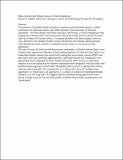| dc.contributor.author | Muller, Martin N. | |
| dc.contributor.author | Thompson, Melissa Emery | |
| dc.contributor.author | Kahlenberg, Sonya M. | |
| dc.contributor.author | Wrangham, Richard | |
| dc.date.accessioned | 2009-04-21T01:39:41Z | |
| dc.date.issued | 2009 | |
| dc.identifier.citation | Martin N. Muller, Melissa E. Thompson, Sonya M. Kahlenberg, Richard W. Wrangham. 2009. Male coercion and female choice in wild chimpanzees. American Journal of Physical Anthropology 138(S48): 196. | en |
| dc.identifier.issn | 0002-9483 | en |
| dc.identifier.uri | http://nrs.harvard.edu/urn-3:HUL.InstRepos:2797426 | |
| dc.description.abstract | The question of whether female primates, in promiscuously breeding species, exhibit preferences for particular males, and subtly attempt to bias paternity, is famously intractable. Previous studies from three sites have shown that, in wild chimpanzees (Pan troglodytes), females mate more restrictively during the fertile period, and this has been taken as evidence for female choice. A common problem with these studies, however, was a failure to test whether females sexual solicitations and refusals, during periods when females are most attractive, resulted from free choice or from fear of male aggression.
We used 10 years of data from the Kanyawara community in Kibale National Park to test whether male aggression influences female mating patterns. As with previous studies, we found that females mated more restrictively during the periovulatory period (POP), and that males who were generally approached by individual females for copulations were approached more frequently by those females during the POP. However, individual females at our site initiated periovulatory copulations most frequently with the males who had been most aggressive toward them throughout their cycles (i.e. during both estrous and non-estrous periods). We interpret this as evidence for a form of “conditioning aggression” in which males are aggressive in a variety of contexts to manipulate female sexuality over the long term. We suggest that the resulting mating patterns fit with a model of male coercion, but not with models of female choice based on preferences for “good genes”. | en |
| dc.description.sponsorship | Anthropology | en |
| dc.description.sponsorship | Human Evolutionary Biology | |
| dc.language.iso | en_US | en |
| dc.publisher | John Wiley & Sons | en |
| dc.relation.isversionof | http://dx.doi.org/10.1002/ajpa.21030 | en |
| dash.license | OAP | |
| dc.title | Male coercion and female choice in wild chimpanzees | en |
| dc.type | Other | |
| dc.description.version | Accepted Manuscript | |
| dc.relation.journal | American Journal of Physical Anthropology | en |
| dash.depositing.author | Wrangham, Richard | |
| dc.identifier.doi | 10.1002/ajpa.21030 | * |
| dash.contributor.affiliated | Wrangham, Richard | |


